
Mammals are a group of vertebrate animals constituting the class Mammalia, and characterized by the presence of mammary glands which in females produce milk for feeding (nursing) their young, a neocortex, fur or hair, and three middle ear bones. These characteristics distinguish them from reptiles and birds, from which they diverged in the Carboniferous, over 300 million years ago. Around 6,400 extant species of mammals have been described. The largest orders are the rodents, bats and Eulipotyphla. The next three are the Primates, the Artiodactyla, and the Carnivora.

Xenarthra is a major clade of placental mammals unique to the Americas. There are 31 living species: the anteaters, tree sloths, and armadillos. Extinct xenarthrans are the glyptodonts, the ground sloths, and the aquatic sloths. Xenarthrans originated in South America during the Paleocene about 59 million years ago. They evolved and diversified extensively in South America during the continent's long period of isolation in the early to mid Cenozoic Era. They spread to the Antilles by the early Miocene and, starting about 3 Mya, spread to Central and North America as part of the Great American Interchange. Nearly all of the formerly abundant megafaunal xenarthrans became extinct at the end of the Pleistocene.
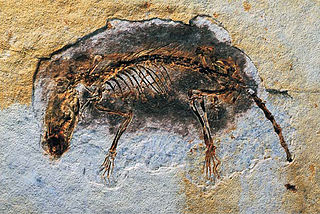
Eomaia is a genus of extinct fossil mammals containing the single species Eomaia scansoria, discovered in rocks that were found in the Yixian Formation, Liaoning Province, China, and dated to the Barremian Age of the Lower Cretaceous about 125 million years ago. The single fossil specimen of this species is 10 centimetres (3.9 in) in length and virtually complete. An estimate of the body weight is between 20–25 grams (0.71–0.88 oz). It is exceptionally well-preserved for a 125-million-year-old specimen. Although the fossil's skull is squashed flat, its teeth, tiny foot bones, cartilages and even its fur are visible.

Marsupial moles, the Notoryctidae, are highly specialized marsupial mammals, known from two species found at the Australian interior.

Afrotheria is a clade of mammals, the living members of which belong to groups that are either currently living in Africa or of African origin: golden moles, elephant shrews, tenrecs, aardvarks, hyraxes, elephants, sea cows, and several extinct clades. Most groups of afrotheres share little or no superficial resemblance, and their similarities have only become known in recent times because of genetics and molecular studies. Many afrothere groups are found mostly or exclusively in Africa, reflecting the fact that Africa was an island continent from the early Cenozoic until around 25 million years ago, when the Tethys Sea shrank.
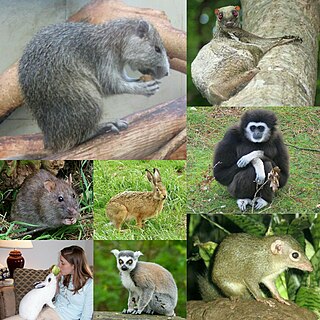
Euarchontoglires is a clade and a superorder of mammals, the living members of which belong to one of the five following groups: rodents, lagomorphs, treeshrews, colugos and primates.
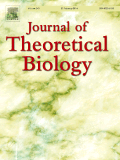
The Journal of Theoretical Biology is a biweekly peer-reviewed scientific journal covering theoretical biology, as well as mathematical, computational and statistical aspects of biology. Some research areas covered by the journal include cell biology, evolutionary biology, population genetics, morphogenesis, and immunology. It is often referred to informally by the initials 'JTB'.
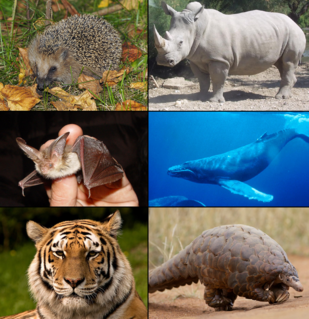
Laurasiatheria is a clade of placental mammals that includes hedgehogs, even-toed ungulates, whales, bats, odd-toed ungulates, pangolins, and carnivorans, among others. The clade originated on the northern supercontinent of Laurasia. Its last common ancestor is supposed to have diversified ca. 76 to 91 million years ago.

The start codon is the first codon of a messenger RNA (mRNA) transcript translated by a ribosome. The start codon always codes for methionine in eukaryotes and Archaea and a N-formylmethionine (fMet) in bacteria, mitochondria and plastids. The most common start codon is AUG.

The Annual Review of Ecology, Evolution, and Systematics is an annual scientific journal published by Annual Reviews. The journal was established in 1970 as the Annual Review of Ecology and Systematics and changed its name beginning in 2003. It publishes invited review articles on topics considered to be timely and important in the fields of ecology, evolutionary biology, and systematics. According to the Journal Citation Reports, its 2019 impact factor is 14.041, ranking it second of 168 journals in the "Ecology" category and second of 50 journals in "Evolutionary Biology".

The evolution of mammalian auditory ossicles was an evolutionary event that resulted in the formation of the bones of the mammalian middle ear. These bones, or ossicles, are a defining characteristic of all mammals. The event is well-documented and important as a demonstration of transitional forms and exaptation, the re-purposing of existing structures during evolution.

Takashi Gojobori, is a Japanese molecular biologist, Vice-Director of the National Institute of Genetics (NIG) and Distinguished Professor at Center for Information Biology and DNA Data Bank of Japan (DDBJ) in NIG, Mishima, Japan. He has also been co-appointed as the Special Research Consultant of the National Institute of Advanced Industrial Science and Technology (AIST), as a Visiting Professor of Keio University, University of Tokyo, and Tokyo Institute of Technology and as a Visiting Research Director of RIKEN.

Evolutionary Bioinformatics is a peer-reviewed open access scientific journal focusing on computational biology in the study of evolution. The journal was established in 2005 by Allen Rodrigo and is currently edited by Dennis Wall. It was originally published by Libertas Academica, but SAGE Publications became the publisher in September 2016.

Monotremes are one of the three main groups of living mammals, along with placentals (Eutheria) and marsupials (Metatheria). The monotremes are typified by structural differences in their brains, jaws, digestive tract, reproductive tract, and other body parts compared to the more common mammalian types. In addition, they lay eggs rather than bearing live young, but, like all mammals, the female monotremes nurse their young with milk.
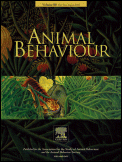
Animal Behaviour is a double-blind peer-reviewed scientific journal established in 1953 as The British Journal of Animal Behaviour, before obtaining its current title in 1958. It is published monthly by Elsevier for the Association for the Study of Animal Behaviour in collaboration with the Animal Behavior Society. It covers all aspects of ethology, including behavioural ecology, evolution of behaviour, sociobiology, ethology, behavioural physiology, population biology, and navigation and migration.
Animal Welfare is a quarterly, peer-reviewed scientific journal covering studies on the welfare of animals, whether in captivity or in the wild. Its scope includes animal welfare science, animal cognition, ethology, behavioural ecology, evolution of behaviour, sociobiology, behavioural physiology, population biology, neurophysiology and abnormal behaviour. It was established in 1992 and is published by the Universities Federation for Animal Welfare. The editor-in-chief is James K. Kirkwood.
Plant Systematics and Evolution is a biannual peer-reviewed scientific journal covering systematic botany and evolutionary biology. The editors-in-chief are Marcus A. Koch, Martin A. Lysak,, and Karol Marhold.

Steve David Macleod Brown is director of the Medical Research Council (MRC) Mammalian Genetics Unit, MRC Harwell at Harwell Science and Innovation Campus, Oxfordshire, a research centre on mouse genetics. In addition, he leads the Genetics and Pathobiology of Deafness research group.
The Journal of Helminthology is a bimonthly peer-reviewed scientific journal established in 1923. It covers all aspects of pure and applied helminthology, particularly those helminth parasites of environmental health, medical, or veterinary importance. According to the Journal Citation Reports, the journal has a 2014 impact factor of 1.421.

Emma Caroline Teeling is an Irish zoologist, geneticist and genomicist, who specialises in the phylogenetics and genomics of bats. Her work includes understanding of the bat genome and study of how insights from other mammals such as bats might contribute to better understanding and management of ageing and a number of conditions, including deafness and blindness, in humans. She is the co-founder of the Bat1K project to map the genomes of all species of bat. She is also concerned with understanding of the places of bats in the environment and how to conserve their ecosystem.
















